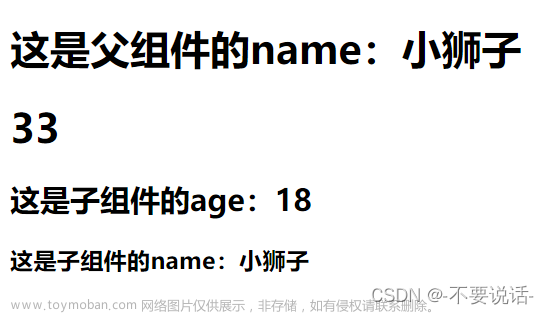初学vue
简介
1、v-bind="$props": 可以将父组件的所有props下发给它的子组件,子组件需要在其props:{} 中定义要接受的props。
2、v-bind="$attrs": 将调用组件时的组件标签上绑定的非props的属性(class和style除外)向下传递。在子组件中应当添加inheritAttrs: false(避免父作用域的不被认作props的特性绑定应用在子组件的根元素上)。
3、v-on="$listeners":通过this.emit(‘事件名’,数据),将底层级的信息往高层级传递。
1、v-bind=“$props”
有如下层级关系:
父组件TheOuter想向子组件TheInner传值
<App>
<TheOuter>
<TheMiddle>
<TheInner>
</TheInner>
</TheMiddle>
</TheOuter>
</App>
- App.vue
<template>
<div id="app">
<!--往下传值-->
<TheOuter :id="1" :name="'jack'" :age="21"></TheOuter>
</div>
</template>
<script>
import TheOuter from "./components/TheOuter.vue";
export default {
name: "App",
components: {
TheOuter,
},
};
</script>
- TheOuter.vue
<template>
<div>
<!--继续往下传值-->
<!--<TheMiddle :id="id" :name="'name'" :age="age"></TheMiddle>--> <!-- 不使用v-bind="$props"时这么传值 -->
<TheMiddle v-bind="$props" gender="man"></TheMiddle>
</div>
</template>
<script>
import TheMiddle from "./TheMiddle.vue";
export default {
name: "TheOuter",
components: { TheMiddle },
props:['id','name','age'], // 接收prop值
data() {
return {};
},
mounted() {
console.log(this.id, this.name, this.age,"这是TheOuter组件");
},
};
</script>
- TheMiddle.vue
<template>
<div>
<!--继续往下传值-->
<!--<TheInner :id="id" :name="'name'" :age="age"></TheInner>--> <!-- 不使用v-bind="$props"时这么传值 -->
<TheInner v-bind="$props"></TheInner>
</div>
</template>
<script>
import TheInner from "./TheInner.vue";
export default {
name: "TheMiddle",
components: { TheInner },
props:['id','name','age'], // 接收prop值
data() {
return {};
},
mounted(){
console.log(this.id, this.name, this.age,"这是TheMiddle组件");
}
};
</script>
- TheInner.vue
<template>
<div>
<div>hello啊</div>
</div>
</template>
<script>
export default {
name: "TheInner",
props: ["id", "name", "age"], // 接收prop值
data() {
return {};
},
mounted() {
// console.log(this.$props["name"]);
console.log(this.id, this.name, this.age, "这是TheInner组件");
},
};
</script>
2、v-bind=“$attrs”
例如,有如下层级关系:
父组件TheOuter想向子组件TheInner传值
<App>
<TheOuter>
<TheMiddle>
<TheInner>
</TheInner>
</TheMiddle>
</TheOuter>
</App>
- App.vue
<template>
<div id="app">
<TheOuter id="1" name="jack" age="21"></TheOuter>
</div>
</template>
- TheOuter.vue
<template>
<div>
<TheMiddle v-bind="$attrs" gender="man"></TheMiddle>
</div>
</template>
// ----------------------------------
mounted(){
// console.log(this.$attrs['id']); // 1
// console.log(this.$attrs['name']); // jack
// console.log(this.$attrs['age']); // 21
}
- TheMiddle.vue
<template>
<div>
<TheInner v-bind="$attrs"></TheInner>
</div>
</template>
// ----------------------------------
mounted(){
// prop中变量的使用
// console.log(this.$attrs['id']); // 1
// console.log(this.$attrs['name']); // jack
// console.log(this.$attrs['age']); // 21
// console.log(this.$attrs['gender']); // man
}
- TheInner.vue
<template>
<div>
<div>hello啊</div>
</div>
</template>
// ----------------------------------
mounted(){
// prop中变量的使用
// console.log(this.$attrs['id']); // 1
// console.log(this.$attrs['name']); // jack
// console.log(this.$attrs['age']); // 21
// console.log(this.$attrs['gender']); // man
}
v-bind="$attrs"的作用是将调用组件时的组件标签上绑定的非props的属性(class和style除外)向下传递。
你可以发现,使用了v-bind='$attrs'的组件,都可以使用从上级组件中获取值,并且它的下级组件直接下级组件即便没有用v-bind='$attrs'绑定,同样也可以获取到值。需要注意的是,可以用props来接收传递过来的值,但不要同时用props配置项和
this.\$props['xxx']调用同一个值,因为props优先级比this.$props['xxx']高,会导致this.$props['xxx']的结果为undefined。
3、v-on=“$listeners”
和上面的this.$ attrs['xxx']相反,v-on="$listeners"作用是用于底层级组件向高层级组件传递信息。通过this.$emit()触发事件,来进行信息传递,
例如有父组件TheOuter,子组件TheMiddle,孙组件TheInner 三个组件,如果TheInner传递信息给TheMiddle则可直接使用$emit,如果是TheInner向TheOuter传递信息,则就需要TheInner先$emit给TheMiddle,TheMiddle再$emit给TheOuter,这种方式比较繁琐,则此时可以使用v-on="$listeners"来满足当前需求。
具体使用文章来源:https://www.toymoban.com/news/detail-766805.html
层级关系如下:文章来源地址https://www.toymoban.com/news/detail-766805.html
<App>
<TheOuter>
<TheMiddle>
<TheInner>
</TheInner>
</TheMiddle>
</TheOuter>
</App>
- App.vue
<template>
<div id="app">
<TheOuter></TheOuter>
</div>
</template>
- TheOuter.vue
<template>
<div>
<!-- $emit触发sendMsg事件,sendMsg事件执行sendMsg()方法,输出从底层接收到的值 -->
<TheMiddle @sendMsg='sendMsg'></TheMiddle>
</div>
</template>
// --------------------------------------
methods:{
sendMsg(msg){
console.log("收到信息了,这里是TheOuter.vue组件",msg);
}
}
- TheMiddle.vue
<template>
<div>
<!-- 通过v-on=$listeners 将要触发的事件和数据往上层传递-->
<TheInner v-on="$listeners"></TheInner>
</div>
</template>
// 同样这里也可以调用
mounted(){
this.$listeners.sendMsg()
}
- TheInner.vue
<template>
<div>
<button @click="handleClick">hello啊</button>
</div>
</template>
// -----------------------------------
methods:{
// 点击事件触发的函数
handleClick(){
// 调用this.$emit,往上层传递要触发的事件名和数据
this.$emit("sendMsg",'hello啊')
// 或者
// this.$listeners.sendMsg('hello啊')
}
}
// ------------------------------------
// 或者更简单点写,直接不写方法了
<template>
<div>
<button @click="$emit('sendMsg','hello啊')">hello啊</button>
</div>
</template>
到了这里,关于初学Vue(全家桶)-第n天(vue2):关于v-bind=“$attrs“、v-bind=“$props“ 和v-on=“$listeners“的使用的文章就介绍完了。如果您还想了解更多内容,请在右上角搜索TOY模板网以前的文章或继续浏览下面的相关文章,希望大家以后多多支持TOY模板网!












